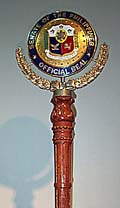
| Home | | |
About | | |
Senators | | |
Committees
| | |
Secretariat | | |
Legislative Documents
|
| |
Publications
|
| | | | Bagong Senado |

|
Symbols of Authority
Seal of the Senate
The Coat of Arms of the Republic, approved by Commonwealth Act No. 731, was the beginning of heraldic tradition in the Philippines where before there was none. What followed thereafter was the implementation of Executive Order No. 310 s. 1940 issued by then President Manuel L. Quezon creating the Philippine Heraldry Committee to make studies and recommend the adoption of coat of arms for the different government offices, semi-government corporations, provinces and chartered cities. President Quezon, in issuing E.O. No. 310, created the Philippine Heraldry Committee to make studies and recommend ways and means for the adoption of coat of arms of the different government institutions, set the pattern of symbols to be used reflecting physical or geographical considerations, significant emblazonry as well as supporting documents, orders or grants. To ensure that the coats of arms of the Republic are manifestations of the ideas and ideals of the offices or the people concerned, the Philippine Heraldry Committee, from the year of its reconstitution on January 7, 1946 to June 30, 1973, encouraged all concerned to submit the designs and the symbolism of the design of their coat of arms limiting the work of the Heraldry Committee to putting in the correct heraldic phraseology the designs submitted for an office, province or city. The Heraldry Committee through the technical staff prepared the final design with the heraldic description for the approval of the President of the Philippines. By coursing through the Office of the President the approval of all representative coats of arms, the duplication of particular symbols was avoided by various offices since most of these coats of arms were used for corporate or administrative seals to authenticate public documents. It is important to indoctrinate all concerned the mechanics of heraldry principally in the division of the shield or escutcheon such as the: 1. Dexter side (right); 2. Sinister side (left); 3. The Chief (top); and 4. The Base (bottom). The positions of charges are: 5. Dexter Chief; 6. Sinister Chief; 7. Middle Chief; 8. Dexter Base; 9. Sinister Base; 10. Middle Base; and 11. Honor Point. The official seal of the Senate of the Philippines is actually an adaptation of the Coat of Arms of the Republic, which was approved on July 15, 1950. This orientation is but inevitable, the Senate being the legislative body of the State. However, certain modifications were recommended to recognize the law-making function of the Senate. As a symbol of the State, the coat of arms of the Republic represents three historical phases — Philippines, Spanish and American. The Sun and the 3 Stars (the Chief) The Philippine symbols are shown in the chief part of the coat of arms. These are the three mullets (5-pointed stars) and the eight-rayed Philippine Sun “in rayonnet” on the heraldic point of honor. The three five-pointed stars indicate the solidarity of Luzon, Visayas and Mindanao. The eight rays of the sun represent the provinces of Manila, Bulacan, Pampanga, Nueva Ecija, Morong, Laguna, Batangas and Cavite, which were declared under Martial Law by a decree of the Spanish government during the revolution of 1896. The three stars and the sun are one and inseparable. The national colors are preserved in tinctures of white (chief and heraldic points of honor); red (dexter base) and blue (sinister base). On the side of the coat of arms are garlands of sampaguita with six sampaguita buds on each side representing the 12 regions of the country. The sampaguita flower also symbolizes honor and dignity, characteristics, which likewise epitomize the Senate as an institution. Below the coat of arms is a scroll with the Latin inscription Legis Servitae Pax Fiat, which means "Law Serves Peace, Let It Be Done.” This Latin maxim embodies the ideals and aspirations of the Senate to pass relevant laws in order to attain peace in the country. The stars arranged in circle surrounding the coat of arms represent the 24 elected Senators of the Senate of the Philippines.  The mace is the symbol of authority of the Senate. Its symbolism strongly holds for the authority of the President of the Senate. It is also the authority of the Sergeant-at-Arms when enforcing order in the Senate. The mace is an essential part of the regalia of the Senate. Without it, the Senate is not considered to be properly constituted. When the Senate is in session, the mace is displayed at the Senate President’s rostrum. Otherwise, it is kept under the custody of the Sergeant-at-Arms. The Sergeant-at-Arms, custodian of the mace, is charged with its use when necessary to preserve order. When the occasion calls for it, or when there is disorder in the session hall, he shall lift the mace from its pedestal and present it before an unruly member in order to restore order or quell boisterous behavior in the Chamber. During medieval times, the mace was a heavy weapon designed to break through strong armor. The bodyguards of the kings of France and England were thus equipped with this weapon to protect the king. In time, the mace became a symbol of the king’s authority. The old mace during the Batasang Pambansa days used to bear only the coat of arms of the Philippines but was later renovated and refurbished in 1987 and now bears the official seal of the Senate of the Philippines.
|
About
|